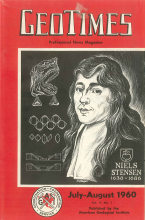The opening page of this issue of Geotimes reads as follows:
Geo-Unity
Geologists gathered in Copenhagen for the XXIst International Geological Congress will be assessing the desirability of greater unity of scientists engaged in the study of the geology, the science of the earth. As the oldest of the scientific congresses, the IGC is viewed by geologists with pride because it has stood the test of time without formal organization. In recent years, however, the effectiveness of the informal union, so well-suited to the desires of many strongly individualistic geologists in serving the needs of the geological sciences, has been challenged. The burgeoning demands to attack global problems of geology and of geologists can scarcely be met without the sustained coordination and support of a permanent organization. The [19]60's cannot be the "Decade of International Geological Research" (DIGR), nor can 1965 be the "Geological Research Achievement Year" (GRAY), without world unity of geologists.
Unity of geologists must be two-dimensional. Obviously there is a great need for global unity of geologists, since geological phenomena have no respect for political boundaries. There is a great need, however, for unity in still another dimension–that of specific specialization. The normal trend is for greater and greater scientific specialization in geology and the fragmentation of geological scientists into smaller and smaller groups. The intense concentration which a specialist brings to his particular area of geological research is unquestionably important to the advancement of geological knowledge. However, geology is a body of interrelated phenomena, so that when the specialist loses his geologic perspective through overspecialization, his effectiveness as a scientist is adversely affected.
Paleontologists, seismologists, geochemists, stratigraphers, volcanologists and all others who form the specialstic groups, on one hand, and the geologists of the many countries of the globe on the other hand, would do well to reflect of the famous quotation from Aesop's The Four Oxen and the Lion. "UNITED WE STAND, DIVIDED WE FALL."
Geoscientists must achieve unity today if they are to retain their identity tomorrow.
Fifty-four years after this article was written, we still experience that the value of geoscience can be masked by our individual scientific passions. We launched the "I'm a Geoscientist" campaign to encourage geoscientists in all of our organizations to first introduce themselves as a geoscientist, and then share their individual scientific passions and expertise to ensure visibility with decision makers and the general public. Plus, when I was interviewing people, asking why they were geoscientists, I found the vast majority of us–regardless of specialization or industry–are passionate and curious about the planet we live on. The call to action for geo-unity is still valid, for it should be every geoscientist's mission to increase public awareness of the vital role the geosciences play in society's use of resources, resilience to natural hazards and interaction with the environment.
- M. Moses

